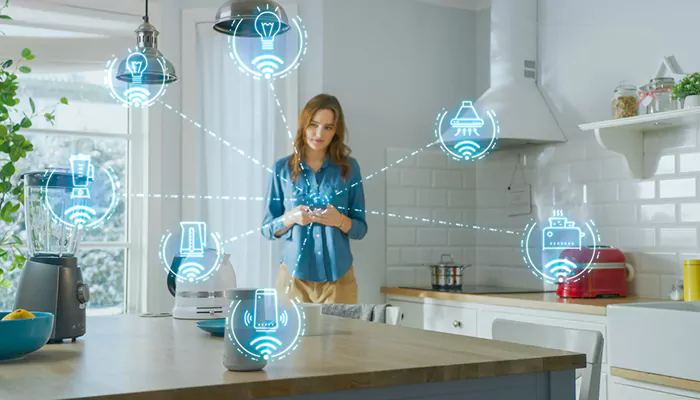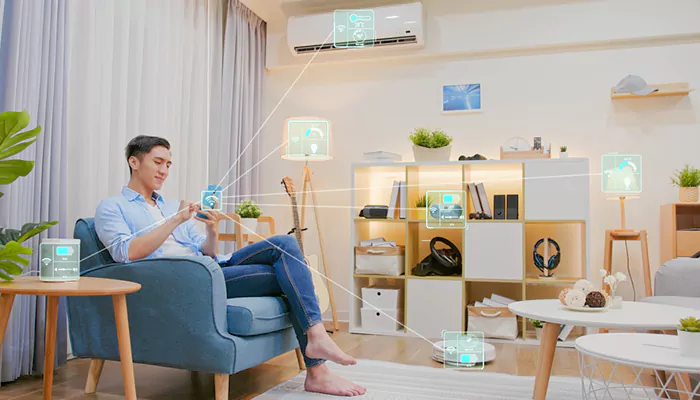Smart Home Innovations: Cutting-Edge Devices for a Connected Living Experience
- Admin
- 1 year ago
- 4 minutes read

Intro: In this article, we explore some of the latest cutting-edge devices that are revolutionizing the smart home landscape.
In the fast-paced world of technology, the concept of a smart home has evolved from a futuristic fantasy to a tangible reality. With innovations in connectivity, artificial intelligence, and automation, smart homes are transforming the way we live, offering convenience, efficiency, and security like never before.
1. Smart Thermostats: Optimizing Comfort and Energy Efficiency
Gone are the days of manually adjusting the thermostat. Smart thermostats have ushered in a new era of climate control, allowing users to regulate temperature settings remotely via smartphone apps or voice commands. These devices utilize advanced algorithms to learn household preferences and adjust settings accordingly, optimizing comfort while reducing energy consumption. Brands like Nest, Ecobee, and Honeywell offer sleek, intuitive smart thermostats equipped with features such as occupancy sensing, geofencing, and integration with other smart home systems.
2. Intelligent Lighting Systems: Enhancing Ambiance and Efficiency
Lighting plays a crucial role in setting the mood and ambiance of a home. Smart lighting systems take this a step further by offering customizable control over brightness, color, and scheduling. LED bulbs equipped with Wi-Fi or Bluetooth connectivity can be remotely controlled using smartphone apps or integrated with voice assistants like Amazon Alexa or Google Assistant. Additionally, advanced features such as motion sensing, dimming, and color-changing capabilities provide flexibility and energy savings, making smart lighting a popular choice for modern homes.
3. Connected Security Cameras: Keeping an Eye on Things
Security is paramount in any home, and smart cameras offer enhanced surveillance capabilities for peace of mind. These cameras provide high-definition video streaming, motion detection, and two-way audio communication, allowing homeowners to monitor their property from anywhere in the world. Cloud storage options ensure that footage is securely stored and accessible at any time, while advanced AI algorithms can differentiate between humans, animals, and other objects, reducing false alarms. With brands like Arlo, Ring, and Nest leading the way, connected security cameras are becoming an indispensable component of smart home security systems.

4. Voice-Activated Assistants: The Hub of Smart Home Control
Voice-activated assistants have emerged as the central hub for controlling smart home devices with ease and convenience. Whether it's turning on lights, adjusting thermostats, or playing music, virtual assistants like Amazon Alexa, Google Assistant, and Apple Siri respond to voice commands, eliminating the need for manual interaction with individual devices. Integration with a wide range of third-party devices and services enables seamless automation and customization, empowering users to create personalized smart home experiences tailored to their preferences.
5. Smart Appliances: Streamlining Daily Tasks
From refrigerators to washing machines, household appliances are getting smarter, offering enhanced functionality and connectivity. Smart refrigerators equipped with touchscreens and cameras allow users to view inventory, create shopping lists, and even order groceries online. Similarly, smart ovens and cooktops feature remote control and pre-programmed cooking settings for effortless meal preparation. Meanwhile, smart washers and dryers offer remote monitoring and diagnostics, notifying users when laundry cycles are complete or if maintenance is required. With smart appliances, mundane household tasks are streamlined, saving time and effort in the process.

6. Automated Home Systems: Simplifying Integration
The true power of a smart home lies in its ability to integrate and automate various devices and systems seamlessly. Automated home systems, often referred to as smart hubs or controllers, serve as the central nervous system, orchestrating communication and coordination between different devices and platforms. These systems offer unified control interfaces, allowing users to manage all connected devices from a single app or dashboard. With support for protocols like Zigbee, Z-Wave, and Wi-Fi, smart hubs ensure compatibility with a wide range of devices, enabling endless possibilities for customization and automation.
With convenience, efficiency, and security at the forefront, smart home devices are not just gadgets but essential tools for enhancing our quality of life in the digital age. Embracing these cutting-edge technologies opens the door to a connected living experience that is more intuitive, personalized, and enjoyable than ever before.












